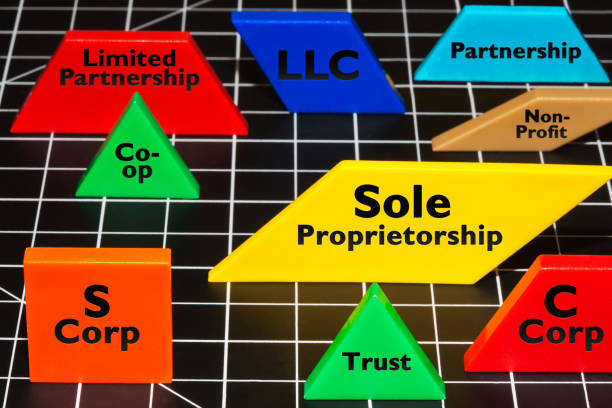Starting a business in the United States can be an exciting venture. However, before diving into any business venture, it is essential to consider the types of business structures available in the United States. The right business structure can help you protect your personal assets, reduce taxes, and limit liability. This article will explore the various types of business structures in the United States.
What is Business Structure?
Business structure refers to the legal and organizational framework of a business. It determines how a business is organized, managed, and operated. The structure of a business can have significant implications for its legal status, tax obligations, management responsibilities, and financial liabilities.
There are several different types of business structures, including sole proprietorships, partnerships, corporations, limited liability companies (LLCs), cooperatives, and nonprofits. Each type of business structure has its own advantages and disadvantages, and the choice of structure depends on various factors such as the size of the business, the number of owners, the liability risks, and the tax implications.
Choosing the right business structure is an important decision that can have a significant impact on the success of a business.
Types of Business Structure in the United States
Below, we will discuss in detail the various types of business structures that exist in the United States.
Sole Proprietorship
A sole proprietorship is the simplest and most common type of business structure in the United States. In this type of business structure, the business is owned and operated by a single individual. The business owner assumes all the risks and liabilities of the business, and there is no legal separation between the owner and the business.
One of the primary advantages of a sole proprietorship is that it is easy and inexpensive to set up. The business owner does not need to file any paperwork or pay any fees to establish the business. Also, the owner has complete control over the business and can make all the decisions without seeking the approval of other shareholders or directors.
However, one of the significant disadvantages of a sole proprietorship is that the owner is personally liable for all the debts and obligations of the business. This means that if the business cannot pay its debts, the owner’s personal assets, such as their home, car, or personal savings, can be seized to settle the debts. Additionally, a sole proprietorship cannot raise capital by selling shares to investors.
Partnership
A partnership is a type of business structure in which two or more individuals own and operate the business. There are two types of partnerships: general partnerships and limited partnerships.
In a general partnership, each partner is responsible for the debts and obligations of the business. Partners also share profits and losses equally, unless they have agreed to a different arrangement in a written partnership agreement. In a limited partnership, there is at least one general partner who is responsible for the debts and obligations of the business, and one or more limited partners who contribute capital but do not participate in the management of the business.
One of the primary advantages of a partnership is that it is easy and inexpensive to set up. Partnerships do not require any special paperwork or fees to establish. Additionally, partnerships can benefit from the complementary skills and resources of each partner.
However, one of the significant disadvantages of a partnership is that each partner is personally liable for the debts and obligations of the business. This means that if the business cannot pay its debts, the personal assets of each partner can be seized to settle the debts. Additionally, partnerships can be complicated to manage, as all partners must agree on all major decisions.
Limited Liability Company (LLC)
A Limited Liability Company (LLC) is a type of business structure that combines the benefits of a corporation with the simplicity and flexibility of a partnership. LLCs are owned by their members, who can be individuals or other businesses, and they are managed by one or more managers or by the members themselves. LLCs offer limited liability protection to their owners, meaning that the personal assets of the members are generally protected from the debts and liabilities of the company.
One of the primary advantages of an LLC is its flexibility. LLCs can be structured in a variety of ways, depending on the needs and goals of the business. They can be owned by a single member or by multiple members, and the members can choose how they want to be taxed. Additionally, LLCs do not have the same formalities as corporations, such as annual meetings and minutes, which can make them easier and less expensive to set up and maintain.
Another advantage of an LLC is that it can offer pass-through taxation. This means that the profits and losses of the LLC are passed through to the members, who report them on their personal tax returns. This can be advantageous because it avoids the double taxation that is common with corporations.
However, one of the significant disadvantages of an LLC is that it can be more expensive to set up and maintain than other business structures, such as a sole proprietorship or partnership. Additionally, LLCs are not well-suited to raising capital through the sale of stock, which can limit their ability to grow and expand. Finally, the laws governing LLCs vary from state to state, which can make it difficult to operate in multiple jurisdictions or to expand into new markets.
Corporation
A corporation is a type of business structure that is legally recognized as a separate entity from its owners. This means that a corporation can enter into contracts, incur debts, and own property in its own name. The owners of a corporation are called shareholders, and they hold shares of stock in the company that represent their ownership stake. The corporation is managed by a board of directors, who are elected by the shareholders, and the day-to-day operations are run by officers, such as a CEO and CFO.
One of the primary advantages of a corporation is that it offers limited liability protection to its owners. This means that the personal assets of the shareholders are generally protected from the debts and liabilities of the corporation. This can be especially beneficial in industries where there is a high risk of lawsuits or other legal action. Additionally, corporations can raise capital by issuing stock, which can be sold to investors in exchange for equity in the company.
Another advantage of a corporation is that it can continue to exist even if the owners change. This means that the corporation can continue to operate even if one or more of the shareholders dies or sells their shares. Additionally, corporations can be structured in a way that allows for the transfer of ownership through the sale of stock, which can make it easier for owners to exit the business or pass it on to their heirs.
However, one of the significant disadvantages of a corporation is that it is subject to double taxation. This means that the corporation pays taxes on its profits, and then the shareholders pay taxes again on any dividends they receive. Additionally, corporations can be more complicated and expensive to set up and maintain than other business structures. They require formalities, such as annual meetings and minutes, and can require legal and accounting services to ensure compliance with state and federal regulations.
Cooperative
A cooperative is a type of business structure in which the business is owned and operated by its members. Cooperatives are common in industries such as agriculture, retail, and utilities. The main idea behind a cooperative is to pool resources and share the benefits of ownership among a group of like-minded individuals. The members of a cooperative have equal say in the management of the business, regardless of the size of their investment.
One of the primary advantages of a cooperative is that it can provide access to resources that might be otherwise unavailable to individual members. By pooling their resources, members can benefit from economies of scale, access to larger markets, and shared equipment and facilities. Additionally, cooperatives can benefit from the collective bargaining power of their members, which can help to negotiate better prices for supplies or higher prices for their products. This can result in increased profitability for the cooperative and its members.
Another advantage of a cooperative is that it can offer products and services at lower prices than traditional businesses. Since cooperatives are not focused on generating profits for shareholders, they can offer products and services at cost or at a lower margin than their competitors. This can be especially beneficial in markets where traditional businesses have a dominant market position or where access to certain products or services is limited.
However, one of the significant disadvantages of a cooperative is that it can be challenging to raise capital, as members are not likely to invest large sums of money in the business. Additionally, cooperatives can be complicated to manage, as all members must agree on all major decisions. This can make it difficult to make decisions quickly or respond to changes in the market. Cooperatives also require a high degree of trust and cooperation among members, which can be difficult to maintain over time.
Nonprofit
A nonprofit organization is a type of business structure that is established for charitable, religious, educational, scientific, or other socially beneficial purposes. Nonprofits are exempt from paying federal income tax, and they are eligible to receive tax-deductible donations from individuals and corporations. The primary goal of a nonprofit is not to generate profits for shareholders but rather to advance a social cause or mission.
One of the primary advantages of a nonprofit is that it can pursue a mission that is not primarily focused on generating profits. This can be especially attractive to individuals and organizations that are motivated by a desire to make a positive impact on society. Additionally, nonprofits can benefit from tax-exempt status, which can reduce their costs and increase their financial flexibility.
Nonprofits can also be eligible for grants and other forms of financial support from government agencies, private foundations, and other organizations. This can provide a stable source of funding that can help to support the mission of the nonprofit over the long term.
However, one of the significant disadvantages of a nonprofit is that it can be challenging to raise funds, as many donors may be more interested in supporting for-profit businesses. Additionally, nonprofits are subject to a variety of legal requirements, including the need to file annual reports and maintain accurate financial records. This can be time-consuming and costly, and can require a significant investment in administrative resources.
What Micahguru Formations Can Do for You?
If you’re looking to start a business in the United States, one of the first decisions you’ll need to make is which business structure to choose. At Micahguru Formations, we can help you navigate this decision by providing a comprehensive overview of the different options available.
Whether you’re looking to form a sole proprietorship, partnership, LLC, or corporation, we can guide you through the advantages and disadvantages of each. We’ll also help you understand the legal and tax implications of each business structure, so you can make an informed decision that suits your specific needs and goals.
At Micahguru Formations, we’re committed to helping entrepreneurs like you achieve success by providing the resources and support you need to build a strong foundation for your business. Contact us today to learn more about how we can help you get started.
Conclusion
Choosing the right business structure is an important decision for any entrepreneur. Each type of business structure has its advantages and disadvantages, and the right choice will depend on the needs and goals of the business.
Whether you choose a sole proprietorship, partnership, LLC, corporation, cooperative, or nonprofit, it is important to consult with an attorney or accountant to ensure that you understand the legal and financial implications of your choice. With the right structure in place, you can protect your personal assets, reduce your taxes, and focus on growing your business.



